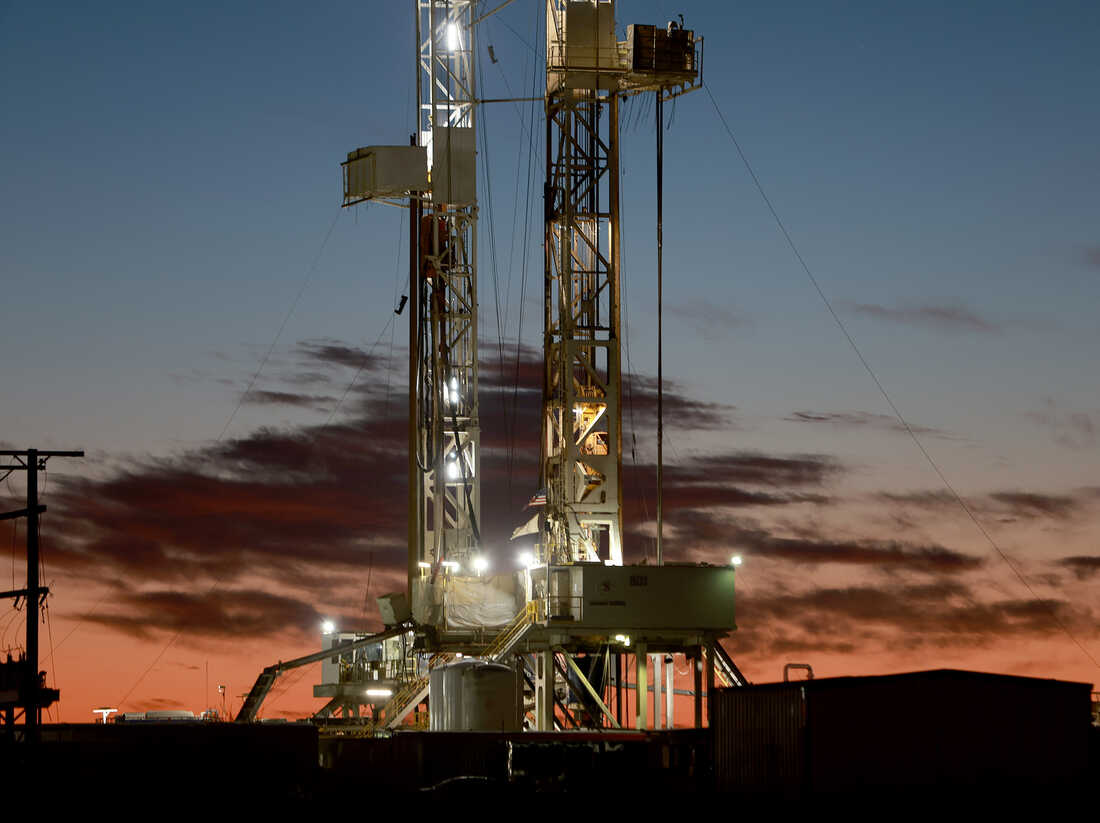A gas pump is seen at a Shell gas station in Houston on April 1. Brandon Bell/Getty Images hide caption
toggle caption
Brandon Bell/Getty Images
It’s going to get even more volatile in energy markets – and hence for gasoline prices.
Crude prices jumped on Wednesday after the European Union proposed a ban on oil imports from Russia as part of a new round of sanctions targeting the country after its invasion of Ukraine.
The details are still being hammered out, and the proposal needs to be unanimously agreed upon by the 27 members of the bloc before going into effect.
Brent crude, the global benchmark for oil, jumped more than 4% on the news and was trading at around $110 a barrel.
Here’s what the proposed EU ban could mean for global oil markets and gasoline prices in the U.S.
How much impact will there be on oil markets?
Crude prices will likely go even higher still after already surging following Russia’s invasion of Ukraine.
Europe is hugely dependent on Russian oil imports. It gets about a quarter of its oil from Russia, by far the biggest single source of oil imports into the continent.
Though Russia could find other buyers like India for the crude, it’s unlikely that Russia will be able to sell the entire allotment that would usually go to Europe.
Heavy sanctions have made some traditional buyers reluctant to deal with Russia. And as part of its latest proposal, the EU is also seeking to ban European ships from transporting Russian oil.
Ultimately it’s expected that an EU ban on Russian oil imports will result in a loss of 2 million barrels a day from Russia.

European Commission President Ursula von der Leyen making a statement in Brussels on April 27 following the decision by Russian energy giant Gazprom to halt gas shipments to Poland and Bulgaria. Kenzo Tribouillard/POOL/AFP via Getty Images hide caption
toggle caption
Kenzo Tribouillard/POOL/AFP via Getty Images
In fact, the U.S. has been urging Europe to be cautious when the region was considering its oil ban given that Russia could make up the loss of revenue from sales to the EU through higher crude prices.
There are factors that could contain oil prices, however.
Lockdowns in China to deal with an outbreak of Covid-19 cases are expected to reduce global demand for crude, though it’s hard to say how long the measures will last.
What does the EU ban mean for gasoline prices?
European citizens will be hit hard for sure, but even in the U.S., it’s hard to see any relief in sight to gas prices.
After all, what consumers pay at the pump is most directly affected by the global price of crude.
When the price of oil spiked following Russia’s invasion of Ukraine, the average price of gasoline in the U.S. shot up above $4 a gallon and has remained there since, according to data from the American Automobile Association.
The U.S. is also approaching the summer season, when traditionally more people take to the road.

An oil drilling rig setup in the Permian Basin oil field in Midland, Texas, is pictured on March 13. Joe Raedle/Getty Images hide caption
toggle caption
Joe Raedle/Getty Images
Something that has tempered gas prices, however, is the Biden administration’s release of emergency oil from the strategy oil reserve. The U.S. is releasing about a million barrels a day and will tap up to 180 million barrels.
Al Salazar, senior vice president with Enverus Intelligence, says if it hadn’t been for the emergency oil release, gasoline prices would have jumped even higher than they already are.
“You’ve basically alleviated any chance of ridiculous oil prices for the summer,” says Salazar.
But there are obvious big question marks about what happens after the U.S. reaches its planned 180 million barrel limit. A lot will depend on the conditions in crude markets at the time.
Can other oil producers step up production?
It’s complicated.
The oil cartel OPEC and its allies, a group known as OPEC+, is in the best position to make up for lost supply, but that’s unlikely.
For one, Russia is a member of OPEC+. Any moves against Russia risks jeopardizing the alliance that has long been important to stabilizing the global price of oil.

Saudi Minister of Energy Prince Abdulaziz bin Salman arrives for an OPEC meeting in Vienna, Austria, on Dec. 5, 2019. Joe Klamar/AFP via Getty Images hide caption
toggle caption
Joe Klamar/AFP via Getty Images
A bigger concern is that some members of OPEC+ are struggling to meet their current quotas due to political strife and underinvestment.
OPEC+ countries have been gradually increasing production by about 430,000 barrels per day since last summer, in a steady effort to get back to pre pandemic levels of production.
OPEC+ meets again on Thursday and is largely expected to maintain its current plans to increase production only gradually.
What about U.S. producers?
The U.S. is the world’s biggest producer of oil, but most of that oil is consumed domestically.
Drilling more is a lot easier said than done. It takes months for even the fastest producers to build a new well. And labor challenges and supply chain problems are lengthening that timeline.
Oil companies are still proceeding cautiously. These companies are beholden to their investors, and those investors don’t want to invest in further drilling.
They lost a ton of money in the oil crash at the beginning of the pandemic, and growing concerns about environmental impact are making them hesitant to invest further.
That said, U.S. producers aren’t completely dragging their feet.
The U.S. Energy Information Administration forecasts that U.S. producers will increase output by an average of 800,000 barrels a day this year.
But it’s hard to go faster than that, and that simply doesn’t make up for the expected loss of Russian oil.

